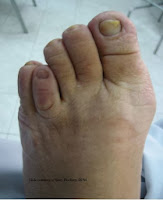This condition typically affects the fourth toe. When looking at the foot, the fourth toe is much shorter than those surrounding it, and it may also appear as if it is raised up, with the third and fifth toes touching below.
The condition may be as a result of a congenital defect or an acquired defect. Congenital causes include Aarskog syndrome and Apert syndrome among others, along with acquired trauma. Simply, the metatarsal bone fails to develop fully, or the growth plate closes prematurely. This condition appears 25 times more in women (1 in 1820) than men (1 in 4586).
Diagnosis is easily done with an x-ray of the affected toe. Usually patients come in with concerns about the toe's appearance, looking for cosmetic surgery to correct the abnormal shape and size, but often learn that there is a significant defect in the bone. Patients may notice that the toe is not carrying its share of the weight, which results in pain and discomfort. They may also have a difficult time selecting shoes because of the toe's shape.
In many cases brachymetatarsia causes no pain or discomfort and will require no treatment beyond careful shoe selection. For some, surgery may be needed.
If you are experiencing some of these symptoms, call our Glastonbury or Middletown office to make an appointment.
Ayman M. Latif, DPM
Connecticut Foot Care Centers
Foot Deformity Doctor in CT
Podiatrist in Glastonbury and Middletown, CT
Visit our website, like our page on Facebook, and follow my tweets on Twitter.
Ayman M. Latif, DPM
Connecticut Foot Care Centers
Foot Deformity Doctor in CT
Podiatrist in Glastonbury and Middletown, CT
Visit our website, like our page on Facebook, and follow my tweets on Twitter.









